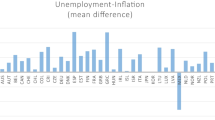Abstract
We study the impact of residential and non-residential investment on economic growth using U.S. data. Unlike previous studies we include the external sector (net exports) in our estimations, and we calculate impulse response analysis using Pesaran and Shin’s (Economics Letters 58:17–29, 1998) generalized impulse response approach. We find that shocks to residential investment have a larger impact on GDP than shocks to non-residential investment, which supports the findings of the closed-economy approach of Coulson and Kim (Real Estate Economics 28:233–247, 2000). However, a closed economy model tends to overstate the importance of residential investment and understate the relevance of nonresidential investment.





Similar content being viewed by others
Notes
See Pesaran and Shin (1998), pp. 18–20.
The dependence of consumption on past income can be due to permanent income considerations (see e.g., Friedman 1957).
In order to have a negatively sloped IS curve we must further assume that \(a_{0} + p < 1 \).
Pesaran and Shin (1998), pages 18–20.
In addition to our argument, others have suggested structural breaks due to changes in productivity which roughly corresponding the timing of the breaks suggested below. See, for instance, Ballard and Duffy (2004).
See, Frankel (2006) and Smith et al. (2006). Frankel for example reports that “[s]ince the mid 1990s, the share of MBS in US bond market has surged to nearly one third of the total outstanding and has remained at a high level...The market has also become more global: the stock of foreign investment in US mortgage securities has increased more than fourfold since 1990, to nearly $1 trillion.”
References
Ballard, J., & Duffy, J. (2004). Federal Reserve Bank of St. Louis Working Paper #2004-016.
Coulson, N. E., & Kim, M. (2000). Residential investment, non-residential investment and GDP. Real Estate Economics, 28, 233–247.
Flemming, J. M. (1962). Domestic financial policies under fixed and under floating exchange rates. IMF Staff Papers 9, 369–379.
Frankel, A. (2006). Prime or not so prime? An exploration of US housing finance in the new century. BIS Quarterly Review, March, 67–78.
Friedman, M. (1957). A theory of the consumption function. Princeton: Princeton University Press.
Green, R. (1997). Follow the leader: How changes in residential and non-residential investment predict changes in GPD. Real Estate Economics, 25, 253–270.
Hicks, J. R. (1937). Mr. Keynes and the classics: A suggested interpretation. Econometrica, 5, 147–159.
Koop, G., Pesaran, M. H., & Potter, S. M. (1996). Impulse response analysis in nonlinear multivariate models. Journal of Econometrics, 74, 119–147.
Mankiw, N. G. (2006). Macroeconomics (6th ed.). New York: Worth Publishers.
Mills, E. (1987). Has the United States overinvested in housing? Journal of the American Real Estate and Urban Economics Association, 15, 601–616.
Pesaran, M. H., & Shin, Y. (1998). Generalized impulse response analysis in linear multivariate models. Economics Letters, 58, 17–29.
Smith, V. L., Pafenberg, F., & Goren, L. (2006). Mortgage markets and enterprises in 2005. Research paper of the Office of Federal Housing Enterprise Oversight.
Swanson, N. R., & Granger, C. W. J. (1997). Impulse response functions based on a causal approach to residual orthogonalization in vector autoregressions. Journal of the American Statistical Association, 92, 357–367.
Author information
Authors and Affiliations
Corresponding author
Additional information
This project was completed with the financial support of The Center for Real Estate Studies at Louisiana Tech University and the Louisiana Real Estate Commission.
Rights and permissions
About this article
Cite this article
Bisping, T.O., Patron, H. Residential Investment and Business Cycles in an Open Economy: A Generalized Impulse Response Approach. J Real Estate Finan Econ 37, 33–49 (2008). https://doi.org/10.1007/s11146-007-9069-z
Published:
Issue Date:
DOI: https://doi.org/10.1007/s11146-007-9069-z




